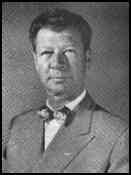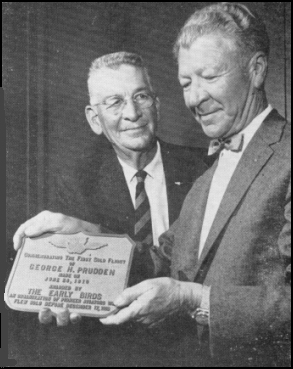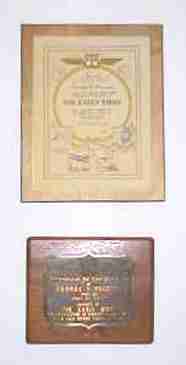1893-1964

| GEORGE H. PRUDDEN 1893-1964 |
||
 |
||
| George H. Prudden, 1961. |
|
1909? I had run several articles in the St. Louis Dispatch telling how to make model airplanes. Two brothers, George and Earl Prudden, sons of one of Father's church members, came in with a biplane model. I had their picture taken---they had on knee pants---and ran it in the Sunday edition. Later, George was the engineer who figured the stresses on the first metal plane in America, and still later he supervised the building of Lockheed's big Constitution airplane. Earl was general manager of the Ryan aircraft plant in San Diego during the second World War. 1922 When I finally got ready to build the all-metal Navy torpedo plane, George had just graduated from the University of Minnesota, having specialized in reinforced concrete structures, with an excellent record. Since I did not want any engineer on this job who would be tied to traditional airplane design, I engaged Geroge Prudden to come to Detroit and undertake a new structural analysis of the metal make-up of the new airplane. Although George was a mathematician, he was not so much of one that it interfered with his engineering. He was more interested in solving a problem than in creating a new formula, and in time he obtained real results from his activities. 1923 We completed it, took it out to Selfridge Field and got Walter Lees, formerly of McCook Field in Dayton, to do our test flying. The first trip with the Air Sedan was made February 9, 1923. Major (Tooey) Spaatz was the commanding officer at Selfridge Field, where the trials were held. The flight was witnessed by Major Spaatz and his staff; Eddie Stinson; Lieutenant C. V. S. Knox, a new Navy inspector; Glenn Hoppin, my brother-in-law, who joined our staff from engineering work in Spokane, Washington, and George Prudden, our chief engineer. |
|
EARLY BIRD Pres. George H. Prudden, right, receives 50 year plaque from South Western Early Bird Regional
Chairman Waldo D. Waterman. Occasion was attended by ten Early Birds and their wives, who were
guests of E. B. Past President Lieut. Col. Dave Young, USAF Ret., and Mrs. Young at the Admiral Yacht
Club at San Diego the night of March 9th. Union-Tribune Publishing Co. San Diego, Calif.) |
 |
Mr. Cooper, The URL to this page was sent by a fellow aviating friend. I appreciate all of the information about my grandfather. Most of his mementos were destroyed in a fire at the Museum of Aviation in San Diego many years ago. The attached picture is his plaque and Early Bird certificate which hang on my wall. Thank you again, George Prudden |
 |
|
George H., Prudden was born in 1893 and died January 20, 1964, aged 70, in a Newport hospital in
California. He was president of the Early Birds of Aviation in 1961. Mr. Prudden studied architecture at the University of Minnesota and applied his basic knowledge to airplanes on the basis of stress analysis. At the age of 17, he made his first solo flight on June 24, 1910, in a plane which he built himself from newspaper descriptions of the Wright Brothers first plane. He was credited with many "firsts" in aviation, one of which was being the first to design and build an internally stressed wing, the first to develop and use the pneumatic rivet hammer in airplane construction, the first to transport an automobile by air, the first to design and build an all-metal plane in the United States, the first to install radial engines in the leading-edge of a wing. These are but a few of his accomplishments. He joined William B. Stout, of Ford trimotor fame, in the manufacture of planes in 1920. He later joined the Lockheed Aircraft Corporation at its founding in 1932 and retired in 1958, as director of quality control. He designed and developed the theory of the elastic center of inertia for determining stress distribution in cantilever wings. He served in the 74th Field Artillery in the First World War. Mr. Prudden is survived by his wife Nancy and a son, Terry. 

|